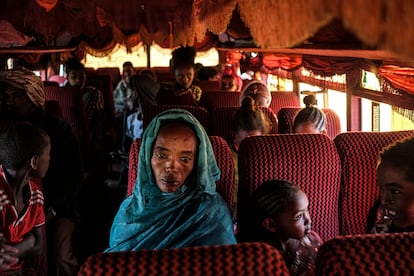Ethiopia’s forgotten war is the deadliest of the 21st century, with around 600,000 civilian deaths
Estimates by European institutions and academics say over half a million non-combatants have died during the Tigray conflict as a result of a government blockade that kept out humanitarian aid

The civil war in Ethiopia has resulted in the death of some 600,000 civilians, a staggering estimate for a conflict that has lasted only two years and has been focused on a single region, Tigray, of around six million inhabitants. However, in the absence of official counts, the calculations of the European Union, international organizations and experts concur on a devastating mortality rate in a war the Ethiopian government has deliberately tried to shield from international public opinion. The first to put these figures on the table was Jan Nyssen, professor emeritus of geography at the University of Ghent in Belgium. “Hunger was used as a weapon of war,” he says.
The conflict erupted in 2020 when Prime Minister Abiy Ahmed Ali declared war on the Tigray People’s Liberation Front, which had dared to challenge the government’s authority from the northernmost region of the country. Violence quickly spread as Amhara militias and Eritrean troops joined the side of the Ethiopian government. Bloody battled ensued, as did bombardments and massacres documented by the United Nations, and a blockade of Tigray that prevented humanitarian aid from getting in and information and residents from getting out. Very few reporters were able to find a way around the Ethiopian government’s blanket ban access to the region. In November 2022, both sides agreed to a ceasefire.
On the same day, United States Ambassador to the United Nations Linda-Thomas Greenfield said that “over 500,000 people” had died during the two-year conflict. A month later, at the Human Rights Forum of NGOs and the European Union, the EU High Representative for Foreign Affairs, Josep Borrell, stated that the figure was somewhere between 600,000 and 800,000 people “killed.” Last week, the African Union High Representative for the Horn of Africa, former Nigerian president Olusegun Obasanjo, called in to broker the ceasefire agreement, placed the number of victims from the Tigray conflict at 600,000 in an interview with the Financial Times.
Placing a precise figure on the number of deaths caused by the war is difficult, as both sides tend to either exaggerate or play down fatalities. However, taking into account the estimated numbers, the war in Ethiopia is one of the deadliest of the 21st century. In Syria, for example, the UN Office for Human Rights claims the decade-long war (2011-2021) had caused 307,000 direct casualties. In Yemen, the UN puts the death toll at the end of 2021 at 377,000, after six years of fighting. The Ukraine war, which began on February 24, 2022, has caused around 7,000 civilian deaths, according to the UN, while US military sources estimate that 200,000 Ukrainian and Russian soldiers have died on the battlefield.
“The figures in Tigray are frightening, we even hesitated to publish them, but the work we did was very rigorous,” says Nyssen, whose team places the number of civilian deaths in the conflict at between 300,000 and 600,000, “without including combatants on both sides, which some military intelligence sources put at between 100,000 and 200,000.″ The three categories included in Nyssen’s study are: victims of bombings and massacres (10% of total fatalities), those who died due to lack of medical assistance because of the closure or shortage of hospitals and health centers (30%), and those who starved to death (60%), at a rate that exceeds 600 deaths per day.

Tigray blockade
During the war, agriculture in Tigray, which in peacetime is a region on the verge of self-sufficiency, was severely affected. But the blockade was the key factor. “There was virtually no electricity or internet connection, trucks with humanitarian aid were stopped at the borders, and fertilizer for crops and food was in short supply,” says Nyssen. Just six months into the conflict, the international index that measures hunger worldwide, the Integrated Food Security Phase Classification (IPC), placed 5.5 million people in Tigray at Phase 4 of the IPC Scale – humanitarian emergency – and 350,000 at Phase 5, which corresponds to famine / humanitarian catastrophe. “According to our calculations, between 437 and 914 people died every day from starvation in Tigray,” adds Nyssen.
A lack of medicine caused by the blockade is another factor that explains the high death rates. Insulin for diabetics, antibiotics, vaccines, and even gauze and antiseptics ran out. In 1990, Ethiopia had a mortality rate of 18/1,000, a figure that had dropped over the past 30 years to 6/1,000 through huge efforts to improve the public health system. “In the two years of war that number went back to 18/1,000, i.e., to the same situation as 30 years ago, or even worse,” says Nyssen. “For example, the only hospital in Mekele that continued to function during the conflict carried out a maternal mortality study and found a five-fold increase.” Professor Tony Magaña of Mekele University places mortality during the war at 32/1,000, the same rate as in 1950.
For their research, Nyssen’s team monitored daily news reports on the war, collected reports from international agencies, made thousands of phone calls to social scientists at Mekele University, used crop maps and contacted health workers in the region. Although a detailed count will be very difficult to obtain, their estimate of up to 600,000 civilian deaths aligns with figures from international agencies.
“It is huge. The blockade was an intentional strategy to turn Tigray into another Biafra. Depriving the civilian population of food is a war crime, but it doesn’t look like anyone is going to be held accountable for it,” says Nyssen. Amnesty International and Human Rights Watch spoke bluntly of ethnic cleansing in a 221-page report published last year under the title “We Will Erase You From This Land.” Some academics have even suggested the Tigray blockade could be considered a genocide, although there is no consensus on this. At present, the guns have fallen silent, but the region remains partially occupied by Eritrean forces and Amhara militias and the blockade has only been partially lifted while of the two million internally displaced persons in Tigray are still unable to return to their homes.
Sign up for our weekly newsletter to get more English-language news coverage from EL PAÍS USA Edition
Tu suscripción se está usando en otro dispositivo
¿Quieres añadir otro usuario a tu suscripción?
Si continúas leyendo en este dispositivo, no se podrá leer en el otro.
FlechaTu suscripción se está usando en otro dispositivo y solo puedes acceder a EL PAÍS desde un dispositivo a la vez.
Si quieres compartir tu cuenta, cambia tu suscripción a la modalidad Premium, así podrás añadir otro usuario. Cada uno accederá con su propia cuenta de email, lo que os permitirá personalizar vuestra experiencia en EL PAÍS.
¿Tienes una suscripción de empresa? Accede aquí para contratar más cuentas.
En el caso de no saber quién está usando tu cuenta, te recomendamos cambiar tu contraseña aquí.
Si decides continuar compartiendo tu cuenta, este mensaje se mostrará en tu dispositivo y en el de la otra persona que está usando tu cuenta de forma indefinida, afectando a tu experiencia de lectura. Puedes consultar aquí los términos y condiciones de la suscripción digital.
More information
Archived In
Últimas noticias
Welcome to the post-religion era: The idea of Christianity as the absolute truth has become obsolete
‘I thought you would like it’: The risky sexual practice popularized by TV shows and TikTok
The digitalization of tourism: ‘They promise experiences and gave us the worst possible one’
Mexican peso defies uncertainty with forecasts of a new period of stability in 2026
Most viewed
- Sinaloa Cartel war is taking its toll on Los Chapitos
- Reinhard Genzel, Nobel laureate in physics: ‘One-minute videos will never give you the truth’
- Oona Chaplin: ‘I told James Cameron that I was living in a treehouse and starting a permaculture project with a friend’
- Why the price of coffee has skyrocketed: from Brazilian plantations to specialty coffee houses
- Silver prices are going crazy: This is what’s fueling the rally










































